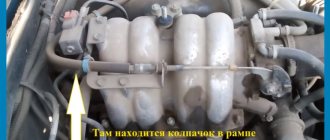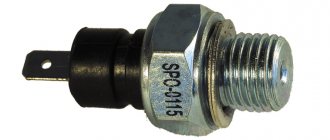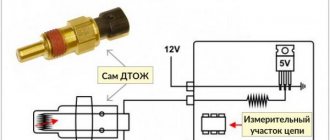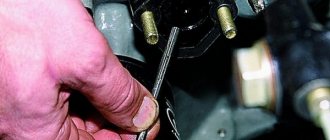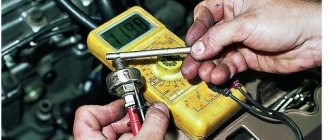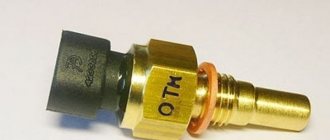Nothing, as they say, was foreshadowed, but what happened happened. While driving in a traffic jam, a “garland” suddenly lit up on the dashboard and the car’s transmission went into emergency mode. Errors on the dash: TPMS system check required Engine check required SCBS system check required
Having connected the laptop and scanned the errors, I saw several errors in different blocks. But as I later realized, the main error code is P0472. In the PCM unit, this error is P0472 - Low voltage of the input signal of the pressure sensor in the exhaust system. In the OBDll unit, this error is P0472 - Abnormality in the exhaust gas back pressure sensor circuit.
Apparently the exhaust gas pressure sensor has failed. But which one exactly? I went to the OD with this question and received a paid consultation =))
The hero of the “triumph” is located here:
On a specialized forum I found a temporary solution: a “trick” of 2 resistors. But while I managed to find out exactly what resistors are needed (and even then I’m not sure that the information is reliable), they have already delivered me a new sensor. About resistors: “I won’t say exactly the nominal value, but you need to get 1V at the signal contact. I even annealed resistors on the machine, I didn’t worry.” - “two 2.2k worked great”
Here, in fact, is the new sensor. Order code SH02-18-211 C
(used to have a "B" at the end)
The new sensor is slightly different in appearance from the old one (partially covered by an orange rubber casing):
After “smoking” this manual a little, I decided that there was nothing complicated and began to change it. Below are short instructions for replacement. There really is nothing complicated, but perhaps it will be useful to someone. I cut the clamp to lift the wiring harness, under which there is a bolt for fastening the metal strip, which in turn holds the sensor hose:
I unscrewed the bolts and pulled out the metal strip:
Disconnected the block (terminal) from the sensor
He loosened the clamp and pulled the sensor fitting out of the hose using rotational and translational movements. I would like to draw your attention to the fact that the plastic fitting of the sensor is relatively long and is reluctant to be pulled out of the hose, plus it is inconvenient to climb up and unclench the clamp.
Next in reverse order:
stuck the fitting of the new sensor into the hose, installed the clamp in place, connected the terminal to the sensor and started the car to check - all the error indicators on the device went out, inserted the metal fastening bar and tightened the bolts (DO NOT overtighten the bolt that is attached to the valve cover, but it we have plastic)
After all this, I connected the scanner and erased the errors:
Issue price: 8838.00 rubles (977.00 - OD diagnostics, 7861.00 - sensor).
UPD 2019
The new sensor with article number SHY6-18-W00 is cheaper and more modernized. The kit includes the sensor itself, mounting bolts, a bracket for a new sensor, wiring and an adapter for a new connector.
Insufficient or too high tire pressure leads to reduced vehicle safety, deterioration of dynamic characteristics and causes increased fuel consumption. Therefore, the Mazda CX 5 uses special sensors.
Mazda CX-5 error p0171
Indications for contacting service are usually the following:
- the engine runs intermittently;
- jerks when moving;
- difficult starting;
- normal operation only when the engine is warm.
Diagnostics shows Mazda CX 5 error p0171 - “lean mixture”. Occurs during long-term fuel correction by 25%. Additionally, inspection of the cylinders with a stethoscope is used. As a rule, carbon deposits are found on the injector nozzles.
What to do
Usually, washing the injectors without removing them helps, but there are more complex situations. Then you have to resort to radical measures:
- washing of injectors with removal;
- ultrasonic cleaning of injectors;
- replacing injectors;
- cleaning the intake manifold;
- cleaning the throttle valve.
To prevent malfunction of Mazda CX 5 error p0171, follow these recommendations:
- refuel your car with recommended fuel at proven gas stations;
- Regularly, preferably every maintenance, wash the injectors.
If a malfunction and error have already appeared, it is better to immediately wash the injectors with complete disassembly. Washing the injectors without removing them may not give results or may help for a short time.
After flushing and cleaning the injection system, it is recommended to replace the spark plugs. Remains of carbon on the spark plugs and misfires can lead to the SCBS error on the Mazda CX 5 - city braking assistance system. When a misfire occurs, the engine control unit perceives the jerks as braking and lights up the warning light.
Kia Sportage
The tire pressure sensor installed on the 2017 Kia Sportage only added to the advantages of this popular car from the Korean manufacturer. The lack of skill in using this option among domestic car enthusiasts led to the question of how to disable the pressure sensor. Its constant operation calls into question the very need to use the system.
Kia Sportage salon
To turn off the signal about a problem in the Kia Sportage tires, you need to check their pressure. This is best done in tire shops using a professional tire pressure gauge. Even minor deviations from the norm of 2.7 atm result in the sensor triggering.
If the result is negative, it is possible to disable the tire pressure sensor in the Kia Sportage only at the company center.
Replace the oxygen sensor (lambda probe)
The oxygen sensor in your car is part of the exhaust system that monitors how much oxygen is not burned in the engine's combustion chamber. This sensor helps control the vehicle's fuel consumption. A malfunctioning oxygen sensor (lambda probe) means that the car computer is receiving incorrect data, which can significantly increase fuel consumption and reduce engine power. Most cars have 2 to 4 oxygen sensors. If you have a home car error scanner, then by connecting it to the car, you can easily find out which sensor needs to be replaced.
For what reason does the oxygen sensor in a car become unusable?
Over time, the sensor becomes covered with a layer of used engine oil (oil soot), which reduces the accuracy of reading sensor readings for regulating the gasoline mixture and distributing the optimum. A malfunction of the oxygen sensor in a car leads not only to, but also to an increased content of harmful CO2 substances in the exhaust.
What to do:
If you do not replace a faulty car oxygen sensor, this can lead to your car's catalyst failing (it may burst), which will result in expensive repairs.
The cost of new catalysts is very high due to the precious alloys they contain. On some cars, there are several catalysts, the cost of which can reach up to 90,000 rubles. So don't delay replacing the sensor. Although replacing the sensor and its cost is not very small, it is not commensurate with the cost of the exhaust gas catalyst system. You can also save on replacement costs by doing it yourself. Many car manuals have detailed instructions on how to replace the oxygen sensor yourself. If you know where the oxygen sensor is located, then it will not be difficult for you to disconnect the faulty lambda probe and replace it with a new one. Remember that you cannot delay replacing this important element!
Check the fuel filler cap
Many drivers, in most cases, when the “check engine” indication appears, will think about serious problems in the car’s engine, but will not even think to check the tightness of the fuel system, which may be compromised due to a defect or an insufficiently tightened fuel tank cap. This is a very common reason for the appearance of the “Check” engine icon.
Reason for the error:
Leakage of the fuel system due to the passage of air through the fuel tank filler cap will increase the vehicle's fuel consumption, to which the vehicle's diagnostic system will generate an engine error by turning on the "Check engine" indication on the vehicle's instrument panel.
What to do:
If, when the “Check” indication appears, your car has not lost power, and there are no audible signs of engine damage (engine knocking, humming, creaking, etc.), then first check the gas tank for leaks.
Your gas cap may be cracked or not tightened enough. If the cap was not tightened enough, then after tightening it all the way, continue driving the car for a while to see if the engine error disappears. To prevent a check engine light from appearing for this reason, check your fuel filler cap regularly. Remember that the cover must be replaced with a new one periodically!
Types of sensors
Based on the type of mounting, sensors are classified into:
- External. They are manufactured in the form of standard caps that are attached to the tire. The main advantages include low cost and ease of operation. The main disadvantage is that any passerby can easily twist this part to sell or install it on their car. Also, when driving at high speeds, there is a risk of losing a part or damaging it.
- Internal. They are installed on the air duct through which the tire is inflated. The design is attached to the disc under the tire, so it is completely invisible. Data is sent to the monitor or smartphone screen via Bluetooth via radio communication.
Car exhaust catalyst
An automobile catalyst helps a car make engine exhaust gases more environmentally friendly. It converts carbon monoxide and other harmful substances into harmless compounds. If your exhaust catalyst has become unusable, you will notice it not only when the engine icon (check) appears, but also long before that, when the car’s power drops by half. For example, when you press the gas pedal, the car will not have good acceleration dynamics as before.
What can cause a car catalyst to fail:
If you regularly service your car in accordance with the car company's maintenance regulations, then the catalyst should not fail. The main reason for catalyst failure is untimely replacement of a faulty oxygen sensor, as well as non-regular replacement of spark plugs when their expiration date expires. When the oxygen sensor or spark plugs are faulty, the conversion of carbon monoxide in the catalyst into harmless chemical elements stops, which leads to overheating of the catalyst, which can therefore fail.
Replace the mass air flow sensor
The mass air flow sensor regulates how much air needs to be added to the gasoline mixture for optimal ignition of the fuel. The sensor constantly reports data to the car's computer about the amount of oxygen supplied. A faulty mass air flow sensor increases fuel consumption, increases CO2 levels in the exhaust gas, and reduces engine power and smoothness. Also, if the sensor is faulty, poor acceleration dynamics are observed. In cold weather, a car with a faulty sensor has difficulty starting.
What are the reasons for the failure of the mass air flow sensor:
Most sensor failures occur due to improper installation of the air filter during its scheduled replacement. Also, if you do not regularly change the air filter, as required by the vehicle maintenance regulations recommended by the manufacturer, the mass air flow sensor may fail.
What to do:
Theoretically, you can drive for a long time with a broken mass air flow sensor (several weeks or months).
But you will notice that the longer you drive, the more your fuel consumption increases. Replacing the sensor in a car service is not that expensive, since the work itself does not take much time and is quite simple. The main costs are related to the cost of the sensor, which for some car models can be 11,000-14,000 rubles if it is an original sensor or up to 6,000 rubles if it is an analogue substitute. Replacing the sensor yourself is very simple. But due to the low cost of replacing the sensor, you can entrust this work to a mechanic at a car service center. Remember that you need to regularly change the air filter, observing the vehicle maintenance regulations!
Activation of FORD sensors
Most Ford vehicles use a special procedure for linking the sensor to the vehicle using a special device to activate tire pressure sensors. On some models, instead of the device, you can use the binding procedure by changing the tire pressure. To bind a new sensor, you must enter the car into a special binding mode for this: The car is entered into programming mode by performing the following action:
- Turn off the ignition, press and release the brake pedal.
- Switch the car from the ignition off mode to the ignition on mode 3 times, leave it in the ignition on position.
- Press and release the brake pedal.
- Turn off the ignition.
- Switch the car from the ignition off mode to the ignition on mode 3 times, leave it in the ignition on position.
Method 1 . Carry out the binding using a specialized tire pressure sensor activator device. To do this, you need to bring the device to the left front wheel and press the activation button on the device. The buzzer will sound. Then repeat the procedure in the following order - front right wheel, rear right wheel, rear left wheel. After completing the binding procedure, a double beep will sound, indicating that the binding was successful.
Method 2 (on some models). Carry out the binding using the pressure difference in the wheel. To do this, you need to start deflating the left front wheel until the horn sounds. Then repeat the procedure in the following order - front right wheel, rear right wheel, rear left wheel. After completing the binding procedure, a double beep will sound, indicating that the binding was successful. The time the car spends in the binding mode is limited and lasts several minutes. The time for tying each wheel is also limited to one minute. If the procedure is not completed within this time interval, the procedure must be started again.
Replacing spark plugs and high-voltage wires
Spark plugs in a car are the main components for igniting the fuel mixture. If the spark plugs are faulty, the spark will not be supplied correctly to ignite the gasoline mixture. Faulty spark plugs often result in a lack of spark or an incorrect spark interval, which results in the engine not running properly. If the spark plugs do not work properly during acceleration, especially from a standstill, you may feel slight jolts.
What are the reasons for spark plug failure:
Most spark plugs in pre-1996 vehicles need to be replaced every 25,000 to 30,000 kilometers. In newer cars, spark plugs last more than 150,000 km. However, these scheduled spark plug replacement intervals may be reduced by various factors related to fuel quality and driving style.
What to do:
If your spark plugs have not been changed for a long time, or you feel failures in the engine operation associated with ignition, then you must immediately replace them with new ones without delay.
Do not try to save money by untimely replacement of spark plugs, since the cost of spark plugs is not very expensive, as well as the work of replacing them. By replacing old spark plugs, you will improve engine performance and reduce your vehicle's fuel consumption. Changing spark plugs yourself is quite easy. Basically, they are easily accessible under the hood of the car. You need a regular spark plug wrench to remove the spark plugs from the engine. It is also advisable to monitor the condition of high-voltage wires, since over time they can become unusable and allow electricity to pass through, which is transferred to the spark plugs, which will reduce the strength of the spark. Remember that regularly replacing spark plugs, in accordance with your car’s maintenance schedule, protects your exhaust catalyst from breakdowns and also improves engine performance!
My problems just started on the regular 95. I have never used additives before in principle, on any car before the CX-5. On the CX-5 for almost 2.5 years, Lil 95 from Shell, everything was ok. Then it started to interfere with the usual 95 from Lukoil and off we went (the traction was gone, the engine roared and didn’t really move, even the automatic transmission shifts during kickdown began to occur with some delay).
I left work on Friday and started it. Here is the first Check engine (engine check required). The oil is fine, there is no unnecessary noise. 37 thousand on the odometer. I restarted it several times (5), and even drove it today. Everything in terms of dynamics seems to be normal, but the light stays on. I made an appointment with the OD on Tuesday. ELM327 no, I can’t check it myself ((Tomorrow on foot. I’ll have to go to the polls
The red Mazda CX-5 set out on a long testing journey on May 13, 2013. Testing of the crossover by the editors of the German magazine “Auto Bild” took place in strict accordance with the plan. From the very first kilometers, the SUV began to collect positive reviews. Most entries praise the 2.2-litre turbodiesel and the well-balanced, comfortable chassis. As you probably guessed, this combination made the Japanese crossover the most popular vehicle for long trips.
During testing, we were pleased with such pleasant details as USB and AUX connectors in the armrest and fast-acting heated seats. After 15,000 km, the test editor summarized: “A pleasant car. Suspension, engine, seats, effective navigation system and spacious interior - the car is four and a half points on a 5-point scale.”
Despite the fact that a number of shortcomings were soon discovered, none of them changed the positive attitude towards the Mazda CX-5. Among the most annoying little things, it is worth noting the following: a license plate light that constantly falls out of its holder, door pockets that are too small, carelessly laid carpet and poor rear visibility.
The carpet is attached very weakly: one movement of the hand, and it forms a slide.
Unfortunately, the idyll soon ended. At the 34,224 km mark, while driving on the highway, the Mazda CX-5 revealed its dark mask. The engine warning light came on and the oil level was too low. This scared the driver seriously. As if this were not enough, the on-board computer warned of the risk of engine seizure.
I had to react quickly: braking, moving into the emergency lane and turning off the engine. The hood is up, the dipstick is in your hands, and on it... there is a normal oil level. After starting the engine, all messages disappeared, as if by magic. Is it possible that this was a false alarm?
Not really. From that moment on, the message appeared quite regularly, and then disappeared again. Of course, this is not a normal situation. Therefore, it was decided to reduce the waiting time for the next maintenance scheduled for 40,000 km, and visit the service now. After draining the old oil, it was discovered that the lubricant was very worn and diluted. It’s strange that the on-board computer did not suggest rushing to visit the service. Perhaps Mazda engineers should take care of this...
Oil pressure
A well-known feature of the first generations of the Mazda CX 5 was the inability to control the condition of the oil in the car. The only way to obtain such data was a probe, which was impossible to use on the go (for obvious reasons).
The problem was aggravated by the fact that many drivers did not even admit the idea that such an important parameter might not be monitored on a car in the 21st century - the Mazda CX 5 had no oil pressure sensor at all.
There was not even a pictogram on the dashboard indicating low oil level and pressure. And this despite the fact that the closest competitors (for example, Nissan Qashqai) had information about this parameter provided by the on-board computer in real time.
It was not uncommon for the owner of a Mazda CX 5 to contact the service center with a complaint that the car was “behaving strangely.” Taught by bitter experience, the technicians first looked at the dipstick under the hood and discovered the “complete absence of any presence” of engine oil. When the driver asked “why didn’t the light on the dashboard light up?”, all he could do was shrug his shoulders - the “light” didn’t light up because it wasn’t there.
After restyling, the opinions of users were taken into account, and the coveted icon finally appeared on the instrument panel. But many were disappointed - it seemed that the alarm system was not working quite adequately.
During the discussions, the opinion was formed that a malfunction in the oil sensor was to blame. However, in fact, a number of reasons can lead to the operation of the display:
- Low oil level in the sump. Daily inspections of the power unit for oil leaks will help confirm the problem. It wouldn’t hurt to inspect the parking area – oil leakage from the sump will make itself felt.
- Non-original filter. The oil filter retains some of the oil inside when the engine is stopped. This is necessary to lubricate the engine when starting the engine. A non-original filter may “lose” oil during long stops and parking with the engine turned off.
- There is a fault in the wiring connecting the oil sensor and the indicator on the screen. The system for monitoring oil level and pressure in the Mazda CX fifth is quite simple. The signal is not processed by electronics; the sensor simply shorts the light bulb to ground. The system is configured in such a way that if there is a wiring or sensor malfunction, the low oil pressure icon lights up - this will help avoid problems associated with a sensor malfunction.
- Reducing valve failure. The pressure relief valve should close automatically when the oil pressure in the system is low. Thus, the oil stops flowing into the sump and the pressure increases. However, if the valve breaks down, the engine fails to “catch up” with pressure, as indicated by the alarm.
- The oil pump is clogged. To prevent dirt from entering the oil pump mechanism, the oil pump inlet is protected by a dirt-collecting mesh. If the mesh becomes clogged, little does not flow into the pump, and the pressure in the engine does not build up and remains low - this is reflected in the display of an icon on the dashboard.
- Oil pump is broken. This case does not need any special comments, because it is the oil pump that is responsible for the oil pressure in the Mazda CX 5 engine. No pump - no pressure.
Oil tracking will save your Mazda CX 5 from problems, and you from paying for expensive repairs. After all, it’s not difficult to calculate how much money driving without oil will cost. It’s better to take care of the well-being of your car in advance, and the grateful “iron horse” will answer you in kind.
Chronology of main events
11,600 km – the right license plate light bulb falls out of the retainer.
36,224 km – alarm message about the oil level being too low.
45,997 km – excellent performance on snow.
50,521 km – high engine speeds after a “cold” start. Irritating at low temperatures.
80,440 km – replacement of front brake discs and pads.
87 389 – the “engine malfunction” light comes on. Another unplanned visit to the service.
The plastic covers on the bottom of the body are secured using plastic clips. But during the test they all got loose.
Mazda cx 5 tpms system check required
Nothing, as they say, was foreshadowed, but what happened happened. While driving in a traffic jam, a “garland” suddenly lit up on the dashboard and the car’s transmission went into emergency mode. Errors on the dash: TPMS system check required Engine check required SCBS system check required
Having connected the laptop and scanned the errors, I saw several errors in different blocks. But as I later realized, the main error code is P0472. In the PCM unit, this error is P0472 - Low voltage of the input signal of the pressure sensor in the exhaust system. In the OBDll unit, this error is P0472 - Abnormality in the exhaust gas back pressure sensor circuit.
Apparently the exhaust gas pressure sensor has failed. But which one exactly? I went to the OD with this question and received a paid consultation =))
The hero of the “triumph” is located here:
On a specialized forum I found a temporary solution: a “trick” of 2 resistors. But while I managed to find out exactly what resistors are needed (and even then I’m not sure that the information is reliable), they have already delivered me a new sensor. About resistors: “I won’t say exactly the nominal value, but you need to get 1V at the signal contact. I even annealed resistors on the machine, I didn’t worry.” - “two 2.2k worked great”
Here, in fact, is the new sensor. Order code SH02-18-211 C
(used to have a "B" at the end)
The new sensor is slightly different in appearance from the old one (partially covered by an orange rubber casing):
After “smoking” this manual a little, I decided that there was nothing complicated and began to change it. Below are short instructions for replacement. There really is nothing complicated, but perhaps it will be useful to someone. I cut the clamp to lift the wiring harness, under which there is a bolt for fastening the metal strip, which in turn holds the sensor hose:
I unscrewed the bolts and pulled out the metal strip:
Disconnected the block (terminal) from the sensor
He loosened the clamp and pulled the sensor fitting out of the hose using rotational and translational movements. I would like to draw your attention to the fact that the plastic fitting of the sensor is relatively long and is reluctant to be pulled out of the hose, plus it is inconvenient to climb up and unclench the clamp.
Next in reverse order:
stuck the fitting of the new sensor into the hose, installed the clamp in place, connected the terminal to the sensor and started the car to check - all the error indicators on the device went out, inserted the metal fastening bar and tightened the bolts (DO NOT overtighten the bolt that is attached to the valve cover, but it we have plastic)
After all this, I connected the scanner and erased the errors:
Issue price: 8838.00 rubles (977.00 - OD diagnostics, 7861.00 - sensor).
UPD 2019
The new sensor with article number SHY6-18-W00 is cheaper and more modernized. The kit includes the sensor itself, mounting bolts, a bracket for a new sensor, wiring and an adapter for a new connector.
Insufficient or too high tire pressure leads to reduced vehicle safety, deterioration of dynamic characteristics and causes increased fuel consumption. Therefore, the Mazda CX 5 uses special sensors.
They promptly detect and inform the driver about deviations in tire pressure from the norm.
Toyota Rav 4
One of the most popular among our compatriots, a model from the Japanese concern Toyota. A reliable car, equipped with tire pressure monitoring sensors and TPMS systems. This system has successfully proven itself in the USA and is considered mandatory for installation, like airbags and seat belts.
Salon Toyota RAV 4 2013 photo
The main problem, according to domestic car enthusiasts, is considered to be the activation of a critical level signal in the wheels after installing non-certified wheels with winter tires. This defect can be solved using:
- Rearranging the original sensors to winter tires in the winter and back in the spring.
- Purchase and installation of new sensors, the price of which starts from 3 thousand/rub., per piece.
- Pressing the shutdown and reboot button. Tire pressure monitoring systems are located to the left of the steering column.
It should be borne in mind that the sensors of the Toyota Rav 4 are powered by a lithium battery. Its service life is 10 years. At the end of which, the malfunction warning system will be triggered.
It is not recommended to dismantle the dashboard (especially if the car is under warranty) and unsolder the warning lamp diode. The method of disabling tire pressure sensors, which is recommended on numerous forums, can lead to serious damage and expensive repairs.
The best option is to contact an official dealer, where, using proprietary software, they will solve this problem at a professional level. Disabling does not take much time and does not affect the performance of other components and assemblies. At the request of the car owner, the reverse connection process is possible.
Installing a tire pressure sensor
Installation and binding of tire pressure sensors is carried out according to the algorithm below:
- Secure the car.
- Jack up the required side.
- Remove the wheel from the vehicle.
- Disassemble the wheel.
- Remove the tire from the rim.
- Remove the existing tire inflation valve. Instead, you will need to install a pressure sensor in the future.
- Remove the ring, washer and valve body from the pressure meter.
- Install the sensor into the mounting hole.
- Tighten the valve. It is not advisable to use excessive force.
- Place the tire on the wheel rim.
- Inflate the tire.
- Check that there is no air leaking through the sensor. If necessary, tighten the valve.
- Install the wheel on the vehicle.
- Inflate the wheels to the required value.
- Perform a “system reset” on the on-board computer.
Typically, sensor binding occurs automatically. If this does not happen, then you need to move the engine start push-button switch to the ON position and then back to OFF or ACC. After this, you should pause for 15 minutes.
To register code signals from sensors and ensure correct operation of the system, you need to drive for 10-30 minutes at a speed of more than 25 km/h. If the warning light does not go off, then you need to stop the car for 15-25 minutes and then continue driving for 10-30 minutes at a speed above 25 km/h. If the binding does not occur, then the problem may be related directly to the sensor.
Tire pressure sensor Mazda CX 5: characteristics and code
Tire pressure sensor
Statistics of accidents on the road eloquently show: one of the most common causes of danger on the road is tires. In winter, this may be due to lost studs or worn out tread pattern. Traditionally, less attention is paid to summer tires, but this is also an important safety parameter.
However, pressure plays an equally important role in ensuring peace of mind on the road. It is not by chance that the manufacturer puts the recommended indicators in the instruction manual. It varies depending on the type of body, the weight of the car, its speed characteristics and, finally, the size of the wheels.
Modern, innovatively equipped cars are equipped with intelligent systems that specialize in monitoring pressure indicators. They are necessary to ensure rapid response to important changes in tires.
- Red car Mazda CX-5 a
- The system will not work correctly if the wheel size does not correspond to the regulated size.
- For the Mazda CX-5, the following dimensional differentiation is relevant:
- R17 – suitable for all generations,
- R18 – only for cars produced in 2014,
- R19 – for all generations.
Summer tires for Mazda CX 5
In this case, the pressure value depends on this indicator.
2.3 bar is recommended for 17th and 18th wheels. R19 – 2.5 bar.
The pressure sensor (TPMS) is activated when the engine starts. It lights up when ignited and goes out if everything is in order. If the pressure in any wheel does not correspond to the regulated pressure, the on-board computer highlights it in red.
In the catalog list, this spare part has article number BHB6-37-140. The quality of the product is guaranteed by Siemens (VDO) France.
According to forums and reviews from car enthusiasts, with correct installation and strict adherence to operational nuances, the uninterrupted service life of the sensor is from 8 years.
Pressure meter
However, there is no specific control system option for the CX-5. The concern distributes one type of sensor to almost the entire model range.
When purchasing a part, a nipple is included in the kit. Installation of the sensor is accompanied by mandatory binding and activation.
Mazda has an automatic binding type. This happens during a test drive.
Entering the device binding mode occurs by resetting the previous settings via the on-board computer. On new versions of cars, the sensor is built in without the need for this procedure.
Binding algorithm:
Mazda CX-5 interior
- Installation of the device on a car,
- Inflating tires to the required level,
- In the on-board computer, select “system reset”, or on the dashboard, deactivate the pressure monitoring system (if the required key is present on the dashboard).
- To set up the correct operation of the sensor, it is recommended to operate the car for half an hour at a speed of 50 km/h.
In the case when the sensor is changed in the spare wheel, it is linked using the diagnostic console. The identifier of a specific device is entered into the car’s intelligent system.
Loading…
Cost and article number for sensors for Mazda CX 5
The original tire pressure sensor for the Mazda CX 5 has the article number BHB637140. Its price ranges from 2000 to 4000 rubles. Sensors from third party manufacturers are commercially available. The table below shows the best analogs that have proven themselves on the Mazda Cx 5.
Table - Tire pressure sensors Mazda CX 5
| Firm | Catalog number | Approximate cost, ruble |
| Jaguar | C2C41655 | 6000-9000 |
| Mobiletron | TXS034 | 1300-2800 |
| Volvo | 31341893 | 5000-7000 |
You can check the functionality of the sensor by forcibly releasing some of the air from the wheel. In this case, after a while a message indicating that the tire pressure is too low should appear. Checking the TPMS system is also possible by reading errors from the on-board computer.
Initializing the TPMS System
Sensors before installation
Initialization (launch) of the TPMS system, on Mazda 6, CX 5, and CX 7 models, is performed after pumping the tires to the established, regulatory value and in the case of:
- Seasonal wheel replacement.
- Disconnecting the battery.
- Constant warning light.
- Replacing the control module or speed sensor.
To reboot, you must press and hold the TPMS SET key until the sound signal turns on once and a warning light appears on the display. If multifunction displays are installed, a message indicating that initialization has been completed will be displayed. If it is triggered frequently, you should also check the tire pressure and repeat the procedure.
Sensors in action
The on-board computer of Mazda 6, CX 5 and CX 7 cars has an open function.
To enable the TPMS system, before initialization, you must go to the settings and make sure that it is connected.
The malfunction sensor may be constantly on and give signals about critical tire pressure if the reminder device is turned on, notifying the time for the scheduled inflation (check) of the wheels. You can disable the function through the on-board computer menu, and then perform a control reboot.


